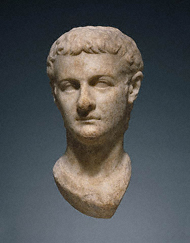 |
 |
 |
 |
Grades/Level: Middle School (6–8)
Subjects: Visual Arts, History–Social Science
Time Required: 2–Part Lesson
2 class periods, plus independent research
Author: J. Paul Getty Museum Education Staff
Permissions: 
The lesson plan and downloadable materials on this page are licensed under a Creative Commons Attribution 4.0 International License. |
 |
|
 |
 |
 |
 |
 |
 |
 |
Lesson Overview |
 |
Students will examine the influence of Greek and Roman mythology on art, discuss strategies of propaganda in an ancient portrait and a 17th-century cabinet, and create a campaign poster for a classroom candidate that uses Greek or Roman iconography. |
 |
 |
 |
 |
 |
Learning Objectives |
 |
Students will be able to:
• analyze the use of Greek figures on a 17th-century cabinet and discuss the long-lasting influence of Greek and Roman symbols and attributes on art;
• draw portraits of rulers based on written descriptions;
• research the use of propaganda in a portrait of Caligula;
• create a campaign poster for a classroom candidate that uses Greek or Roman iconography. |
 |
 |
 |
 |
 |
 |
 |
 |
 |
Materials |
 |
• Reproduction of Cabinet on Stand by André-Charles Boulle
• Reproduction of Head of Emperor Caligula by an unknown Roman artist
• Background Information and Questions for Teaching about the cabinet and bust (click on the thumbnails of the works below)
• Student Handout: Herakles and Hippolyta
• Student Handout: Description of an Emperor
• Pencils
• Paper |
 |
 |
 |
 |
 |
|
|
 |
 |
 |
 |
 |
Lesson Steps |
 |
Download the complete lesson by clicking on the "download this lesson" icon above.
Additional Resource:
Learn more about Cabinet on Stand by André-Charles Boulle and zoom in on its elaborate details.
Watch a video about the process of making marquetry, a technique used to create the decorations on Cabinet on Stand.
Glossary Terms:
Words in bold on these pages and in the lesson are defined in the glossary for this curriculum (see "For the Classroom" links above).
|
 |
 |
 |
| Head of Emperor Caligula, Roman, about A.D. 40 |
 |
|
 |
 |
 |
 |
 |
 |
 |
Standards Addressed |
 |
Common Core Standards for English Language Arts
Grades 6–8
READING
Key Ideas and Details
1. Read closely to determine what the text says explicitly and to make logical inferences from it; cite specific textual evidence when writing or speaking to support conclusions drawn from the text.
2. Determine central ideas or themes of a text and analyze their development; summarize the key supporting details and ideas.
WRITING
Research to Build and Present Knowledge
7. Conduct short as well as more sustained research projects based on focused questions, demonstrating understanding of the subject under investigation.
8. Gather relevant information from multiple print and digital sources, assess the credibility and accuracy of each source, and integrate the information while avoiding plagiarism.
9. Draw evidence from literary or informational texts to support analysis, reflection, and research.
SPEAKING AND LISTENING
Comprehension and Collaboration
1. Prepare for and participate effectively in a range of conversations and collaborations with diverse partners, building on others' ideas and expressing their own clearly and persuasively.
2. Integrate and evaluate information presented in diverse media and formats, including visually, quantitatively, and orally
For more national and California state standards for this curriculum, refer to the charts found in the links at the top right of this page.
|
 |

|
 |
 |
 |




